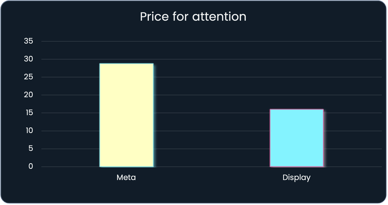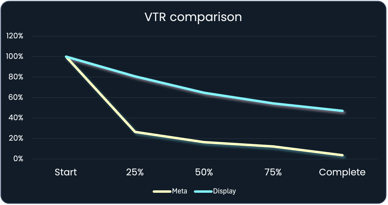Can Meta ads compete for attention?
For years, Meta has dominated digital advertising budgets. But without proper attention insights, it has been hard to compare its effectiveness to the open internet. That’s changing. With our new attention performance modelling, advertisers can now see how Meta stacks up against high impact display ad formats - revealing which impressions are actually worth the spend.
What is an effective ad?
What makes an ad effective? It’s simple: it captures attention. An ad only generates value if someone actually notices it. Without that, all the creative genius and budget in the world amount to nothing.
To optimise media buying for attention, ads need to meet key proxies for sufficient attention:
- On screen for a meaningful amount of time
- Positioned where users actually notice them
Only after securing the right space for long enough can you start worrying about showing the right message to the right person. Without that foundation, even the smartest targeting is wasted.
The Meta paradox
Here’s the puzzle: Meta, one of the world’s largest advertising platforms, doesn’t report on proxies for attention like Time in View and Viewability. These are metrics used across the internet to help gauge whether an ad is actually seen. Moreover, third-party validation and attention measurement on Meta are nearly impossible, making transparency a challenge.
All impressions are not created equal
Whether it’s Meta or the open internet, not every impression carries value. On social media, users endlessly scroll, chasing the next dopamine hit. In this “brainrot culture”, what are the chances that your ad stands out? That it was actually seen? That it made an impact? The odds are low.
Social media isn’t social anymore. When you log on, most of what you see isn’t your friends - it’s algorithmically prioritised brand content and influencer posts. In this environment, capturing attention is harder than ever.
Yet, paradoxically, media budgets heavily favour Meta. The Trade Desk reports that while 60% of time spent online happens on the open internet, only 30% of ad budgets are allocated there. Something doesn’t add up.
Testing Meta’s effectiveness
At Adnami, we decided to put Meta under the microscope. Using our Sonar attention methodology, we modelled attention performance for Meta ads, and the results were telling:
- Lower attention outcomes
- Higher Attentive Cost per Mille (aCPM)
In short, advertisers pay more for less attention on Meta. Here’s what that looks like:


The takeaway? Overallocating media budgets to Meta isn’t just ineffective - it’s costly.
Read more about these results here.
What attention reporting on Meta ads would mean
By translating Meta’s signals into attention KPIs, brands and agencies could:
- Compare Meta and open web outcomes like-for-like
- Direct budgets with greater confidence
- Make smarter investment decisions across channels
Attention is the metric that unifies the ecosystem. By including Meta in the same framework, advertisers could see the full picture - beyond opaque walled gardens and platform-defined metrics.
Want to start comparing attention outcomes across channels?
Attention continues to emerge as a foundational metric for advertising effectiveness. Adnami empowers advertisers to measure, compare, and optimise across platforms, ensuring that every buck spent has real impact.
Let’s talk to get attention reports for your Meta ads with Adnami’s Sonar and make every impression count.


